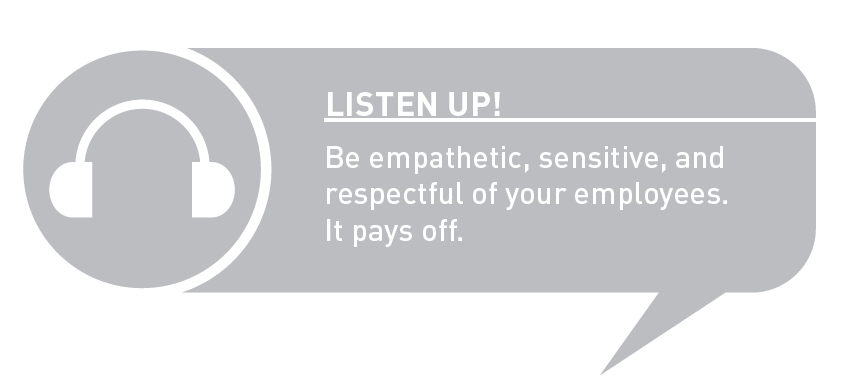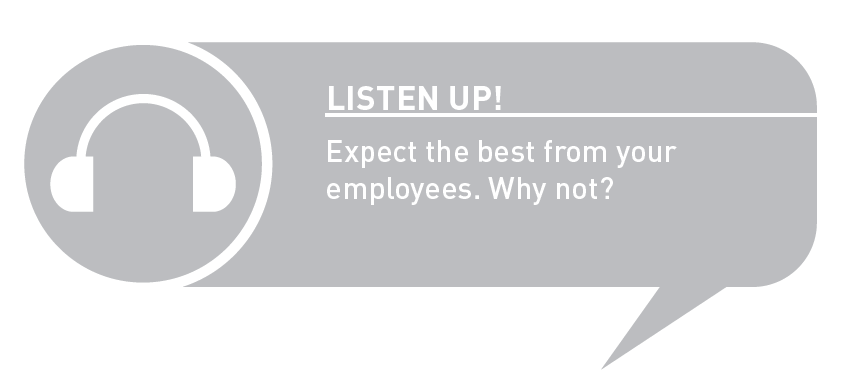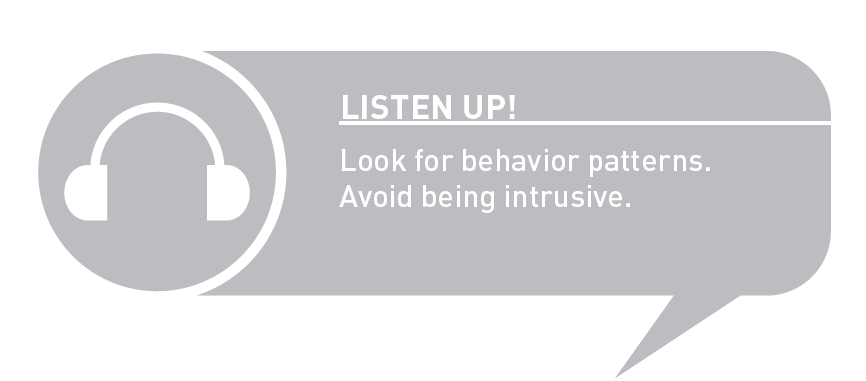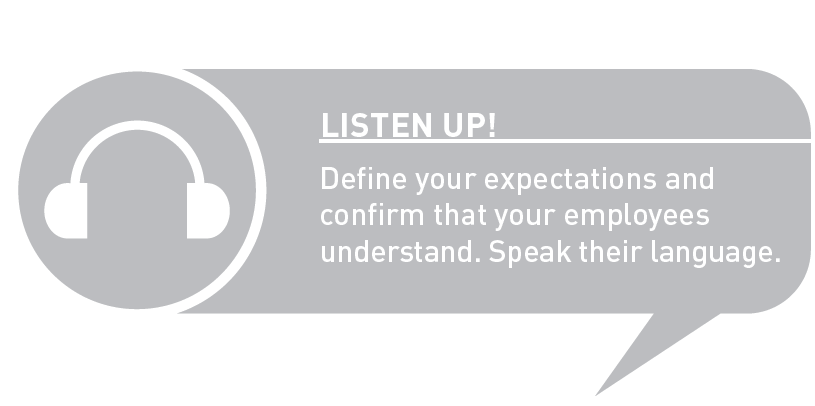Growth
Overview
This step is usually a direct result of a Critical Incident. An employee’s level of engagement may increase (and continue increasing over time) depending on the Critical Incident. It’s a step where the employee sees ample career development, lateral movements, role changes, function changes, knowledge acquisition, vertical movements, stretch assignments, special projects, job rotations, cross-training opportunities, and special assignments. After the employee’s engagement begins to increase in the Growth step, she will return to the Testing the Waters step as she ascertains and redefines her relationship with the company, which was fortified by the lessons learned during the Critical Incident and its resolution.
Before we continue our discussion, we would like you to continue to identify in which step of the Engagement “I” Path your employees are.
Now it’s your turn.
Who is in the Growth step? List the names of those employees who are in this step in Worksheet 5.1.
Worksheet 5.1 Employees in the Growth Step
|
GROWTH |
EMPLOYEE NAMES |
|
|
|
|
|
|
|
|
Drivers
Employee perceptions of fairness and transparency during the Critical Incident will modify subsequent engagement levels. Management and performance management are the primary drivers of employee engagement that exert the most influence in the path that the employee will follow after a Critical Incident, under the Growth step. We will now look at each one of these drivers in the context of the Growth step.
How the company’s management communicates information, provides resources, and models behavior will gain additional saliency for the employee to move to the Growth step. Employee engagement will grow when employees perceive that the management openly shares information, offers resources (such as financial planning or counseling services), and demonstrates empathy in interactions (for example, acknowledgment of employee’s emotional displays).
In terms of performance management, engagement will grow as a result of employees’ perceptions of fairness in performance reviews, development opportunities, and work allocation among other dimensions. Most importantly, employee engagement will grow as an outcome of explicit sensitivity, trust, and respect for the human side of the situation that became the Critical Incident. In return, employees will be more likely to go out of their way to do what is necessary to contribute to the common good.

We will continue to share with you some examples of behaviors that you may notice among your employees. We will now focus on employee behaviors during the Growth step that are related to employee level of engagement. At the end of the list, again we will ask you to identify who is displaying these behaviors.
Employee Behaviors
These are some employee behaviors that you may observe during the Growth step.
- Shows minimal signs of stress.
- Shows atypical punctuality in starting the workday or workweek.
- Dedicates extraordinary efforts to tasks and projects.
- Is willing to spend additional time on work-related activities during the workdays or weekends.
- Increased work-related interactions with peers and managers.
- Values safety and stability.
- Participation in the office grapevine is constructive or minimal.
- Shows overall positive attitude toward the company and the team.
- Speaks positively about the company and growth opportunities.
- Displays company and team logos and symbols with pride.
- Participates in work-related after-hours events.
- Quality of work improves.
Now it’s your turn.
Select which behaviors from this list you have noticed among the employees who are in the Growth step in Worksheet 5.2.
Worksheet 5.2 Behaviors Observed From Employees in Growth Step
|
BEHAVIORS |
EMPLOYEE NAMES |
||
|
Shows minimal signs of stress. |
|||
|
Shows atypical punctuality in starting the workday or workweek. |
|||
|
Dedicates extraordinary efforts to tasks and projects. |
|||
|
Is willing to spend additional time on work-related activities during the workdays or weekends. |
|||
|
Increased work-related interactions with peers and managers. |
|||
|
Values safety and stability. |
|||
|
Participation in the office grapevine is constructive or minimal. |
|||
|
Shows overall positive attitude toward the company and the team. |
|||
|
Speaks positively about the company and growth opportunities. |
|||
|
Displays company and team logos and symbols with pride. |
|||
|
Participates in work-related after-hours events. |
|||
|
Quality of work improves. |
|||
Manager Dos and Don’ts
Here are some examples of what you should and should not do when an employee is in the Growth step.
Dos
- Identify and provide stretch assignments.
- Share the employee’s purpose.
- Involve the employee in decisions about how to complete tasks and provide general guidance to complete them.
- Allow employee autonomy in task-related decisions.
- Facilitate access to resources.
- Encourage interactions within the team and the formation of relationships outside of the team.
- Find opportunities for the employee to interact with other levels of the company.
- Seek ways for the employee to serve as spokesperson or representative of the company.
- Pay close attention to the employee’s signals and behaviors of engagement or disengagement.
- Provide order and structure.
- Guide employees.
- Assign new responsibilities.
- Anticipate and remove barriers for employee performance.
- Allow communication.
- Offer available organizational resources to employee.
- Handle performance issues fairly and equitably (workload, work-life balance, performance management).
- Involve the employee in decisions about his future in the company.
Don’ts
- Only point out mistakes and faults.
- Create incorrect expectations about the employee’s future in the company such as promotions or job security. Remember: not everyone gets every opportunity.
- Monitor every detail of the tasks as they are completed.
- Minimize importance of employee for the company and the team.
- Show favoritism in the team.
- Show disrespect and disregard for the employee.
- Limit employee participation in work-related activities.
- Be secretive about information that can be shared.
- Take advantage of the employee.
- Provide incorrect information.
- Withhold information and organizational resources from the employee.
- Demonstrate low levels of engagement.
- Ignore positive or appropriate actions and behaviors.
- Disregard opportunities to recognize the employee and take achievements for granted.

Now it’s your turn.
Worksheet 5.3 presents a behavior self-assessment for you to identify those behaviors that you have displayed or that you display typically. Place a check mark on the right column to indicate if you display those behaviors, you do not display them, or you display them sometimes.
Worksheet 5.3 Manager Behavior Self-Assessment: Growth Step
|
BEHAVIOR |
YES |
NO |
SOMETIMES |
|
DOS: |
|||
|
Identify and provide stretch assignments. |
|||
|
Share the employee’s purpose. |
|||
|
Involve the employee in decisions about how to complete tasks and provide general guidance to complete them. |
|||
|
Allow employee autonomy in task-related decisions. |
|||
|
Facilitate access to resources. |
|||
|
Encourage interactions within the team and encourage the formation of relationships outside of the team. |
|||
|
Find opportunities for the employee to interact with other levels of the company. |
|||
|
Seek ways for the employee to serve as spokesperson or representative of the company. |
|||
|
Pay close attention to the employee’s signals and behaviors of engagement or disengagement. |
|||
|
Provide order and structure. |
|||
|
Guide employees. |
|||
|
Assign new responsibilities. |
|||
|
Anticipate and remove barriers for employee performance. |
|||
|
Allow communication. |
|||
|
Offer available organizational resources to employee. |
|||
|
Handle performance issues fairly and equitably (workload, work-life balance, performance management). |
|||
|
Involve the employee in decisions about his future in the company. |
|||
|
DON’TS: |
|||
|
Only point out mistakes and faults. |
|||
|
Create incorrect expectations about the employee’s future in the company such as promotions or job security. Remember: not everyone gets every opportunity. |
|||
|
Monitor every detail of the tasks as they are completed. |
|||
|
Minimize importance of employee for the company and the team. |
|||
|
Show favoritism in the team. |
|||
|
Show disrespect and disregard for the employee. |
|||
|
Limit employee participation in work-related activities. |
|||
|
Be secretive about information that can be shared. |
|||
|
Take advantage of the employee. |
|||
|
Provide incorrect information. |
|||
|
Withhold information and organizational resources from the employee. |
|||
|
Demonstrate low levels of engagement. |
|||
|
Ignore positive or appropriate actions and behaviors. |
|||
|
Disregard opportunities to recognize the employee and take achievements for granted. |
-
How many are dos and how many are don’ts?
-
Identify the three don’ts that you would like to turn into dos.
-
Identify the behaviors that you do sometimes and explain why you do so.
Decline
Overview
This step is usually a direct result of a Critical Incident and represents the opposite behaviors of the step that we characterized as Growth. An employee’s level of engagement may decrease (and continue decreasing over time) depending on his interpretation of the dimensions of the Critical Incident. In the example of the reassignments of workspace that we introduced in the discussion of the Critical Incident step, an employee who is assigned to work in a cubicle after working in an office may have a totally different perception of this Critical Incident than an employee who has always worked in cubicles. The employee who will not be working in an office any longer may perceive this change as a loss of privacy, status, and perks, and his levels of engagement will begin to decline.
Now it’s your turn.
Who is in the Decline step? List the names of those employees who are in this step in Worksheet 5.4.
Worksheet 5.4 Employees in the Decline Step
|
DECLINE |
EMPLOYEE NAMES |
|
|
|
|
|
|
|
|
Drivers
The same primary drivers that influence Growth in engagement—namely, management and performance management—will modify subsequent employee engagement levels, but in the opposite direction. We will now look at management and performance management in the context of the Decline step. Employee engagement will decline when they perceive that the management does not share information, denies resources to employees (such as work-related Internet access), and shows inconsistency in behaviors (for example, does not provide napkins for employee coffee breaks but brings out the best china for executive coffee breaks).
In our example of the change in pension plans in YouWillBeHereForever, the engagement levels of the employees who would not be able to retire as planned declined; they believed they had dedicated many years of their lives to the company and expected to retire at a certain time and with a certain level of income, which now will not be there for them. Also, the engagement levels of other employees declined because they no longer believe they should devote years of their lives to an employer without any provisions for their future well-being.
Engagement will also decline when employees do not perceive equality and sensitivity in reward distribution, development opportunities, performance reviews, and flexible arrangements. In the Decline step, how employees see the team’s high and low performers are managed will gain salience, particularly if high performers are assigned the tasks that low performers cannot complete successfully. By requiring additional work from high performers and reducing the workload of low performers, managers would be penalizing high performers and rewarding low performers. Thus, the engagement levels of high performers will begin to decline and other drivers of engagement, such as total rewards, would become a new source of concern for those employees.

We will nowagain share with you some examples of behaviors that you may notice among your employees, focusing on those that occur during the Decline step that are related to employee level of engagement. At the end of the list, again we will ask you to identify who is displaying these behaviors as you continue your plans to increase employee engagement.
Employee Behaviors
These are some employee behaviors that you may observe during the Decline step.
- Shows physical and emotional symptoms of stress and becomes accident-prone.
- Dreads going to work.
- Avoids spending additional hours at work during the week or on weekends.
- Relies more on technology to complete tasks and communicate.
- Devotes minimal effort to tasks and projects.
- Withdraws from social interactions with peers and managers.
- Finds legitimate reasons to work remotely.
- Seeks information to validate his position and find fault in others.
- Speaks negatively about the company in social media sites.
- Openly disregards and rejects company logos and symbols.
- Avoids participating in work-related after-hours events.
- Rejects changes.
- Quality of work deteriorates significantly.
Now it’s your turn.
Select which behaviors from this list you have noticed among the employees who are in the Decline step in Worksheet 5.5.
Worksheet 5.5 Behaviors Observed From Employees in Decline Step
|
BEHAVIORS |
EMPLOYEE NAMES |
||
|
Shows physical and emotional symptoms of stress and becomes accident-prone. |
|||
|
Dreads going to work. |
|||
|
Avoids spending additional hours at work during the week or on weekends. |
|||
|
Relies more on technology to complete tasks and communicate. |
|||
|
Devotes minimal effort to tasks and projects. |
|||
|
Withdraws from social interactions with peers and managers. |
|||
|
Finds legitimate reasons to work remotely. |
|||
|
Seeks information to validate his position and find fault in others. |
|||
|
Speaks negatively about the company in social media sites. |
|||
|
Openly disregards and rejects company logos and symbols. |
|||
|
Avoids participating in work-related after-hours events. |
|||
|
Rejects changes. |
|||
|
Quality of work deteriorates significantly. |
|||

Manager Dos and Don’ts
Here are some suggestions for you to promote employee engagement during this step—and also tips on what you should not do.
Dos
- Express your concern about the employee’s situation.
- Carefully balance positive and developmental feedback.
- Provide pertinent development opportunities.
- Define tasks clearly before assigning them to the employee and communicate quality standards.
- Confirm understanding of instructions.
- Establish realistic and mutually agreed upon timeframes to complete tasks.
- Offer appropriate support for the employee to complete tasks.
- Support and reinforce interactions within the team.
- Maintain the team’s routine meetings and activities.
- Reinforce the value of the employee’s contributions to the team as applicable.
- Pay close attention to employee signals and behaviors of disengagement.
- Give credit where credit is due.
- Anticipate and remove barriers for employee success.
- Communicate, communicate, and communicate.
- Offer available organizational resources to the employee.
- Acknowledge faults and provide “on-the-spot” corrections.
- Handle performance issues fairly and equitably (workload, work-life balance, performance management).
- Provide dignified options to employees.
- Demonstrate empathy whenever necessary.
- Stay away from gossip.
Don’ts
- Assume.
- Play favorites.
- Foster unrealistic expectations about the employee’s opportunities for development in the company.
- Neglect enforcing accountability for quality of work.
- Wait until the last minute to check on the status of tasks.
- Discuss details of private conversations with the employee with other members of the team.
- Reprimand in public.
- Ignore signals and behaviors of engagement or disengagement.
- Be secretive about information that can be shared.
- Provide incorrect information.
- Micromanage.
- Overlook opportunities to recognize and acknowledge employees.
- Be rude, distant, or cold.
- Jump to conclusions.

Now it’s your turn.
Worksheet 5.6 presents a behavior self-assessment for you to identify those behaviors that you have displayed or that you display typically. Place a check mark on the right column to indicate if you display those behaviors, you do not display them, or you display them sometimes.
Worksheet 5.6 Manager Behavior Self-Assessment: Decline Step
|
BEHAVIOR |
YES |
NO |
SOMETIMES |
|
DOS: |
|||
|
Express your concern about the employee’s situation. |
|||
|
Carefully balance positive and developmental feedback. |
|||
|
Provide pertinent development opportunities. |
|||
|
Define tasks clearly before assigning them to the employee and communicate quality standards. |
|||
|
Confirm understanding of instructions. |
|||
|
Establish realistic and mutually agreed upon timeframes to complete tasks. |
|||
|
Offer appropriate support for the employee to complete tasks. |
|||
|
Support and reinforce interactions within the team. |
|||
|
Maintain the team’s routine meetings and activities. |
|||
|
Reinforce the value of the employee’s contributions to the team as applicable. |
|||
|
Pay close attention to employee signals and behaviors of disengagement. |
|||
|
Give credit where credit is due. |
|||
|
Anticipate and remove barriers for employee success. |
|||
|
Communicate, communicate, and communicate. |
|||
|
Offer available organizational resources to the employee. |
|||
|
Acknowledge faults and provide “on-the-spot” corrections. |
|||
|
Handle performance issues fairly and equitably (workload, work-life balance, performance management). |
|||
|
Provide dignified options to employees. |
|||
|
Demonstrate empathy whenever necessary. |
|||
|
Stay away from gossip. |
|||
|
DON’TS: |
|||
|
Assume. |
|||
|
Play favorites. |
|||
|
Foster unrealistic expectations about the employee’s opportunities for development in the company. |
|||
|
Neglect enforcing accountability for quality of work. |
|||
|
Wait until the last minute to check on the status of tasks. |
|||
|
Discuss details of private conversations with the employee with other members of the team. |
|||
|
Reprimand in public. |
|||
|
Ignore signals and behaviors of engagement or disengagement. |
|||
|
Be secretive about information that can be shared. |
|||
|
Provide incorrect information. |
|||
|
Micromanage. |
|||
|
Overlook opportunities to recognize and acknowledge employees. |
|||
|
Be rude, distant, or cold. |
|||
|
Jump to conclusions. |
-
How many are dos and how many are don’ts?
-
Identify the three don’ts that you would like to turn into dos.
-
Identify the behaviors that you do sometimes and explain why you do so.
Next, we will wrap up our discussion of the Engagement “I” Path with the final two steps: Stay or Leave and Re-engage or Disengage. At the conclusion of chapter 6 we will summarize what’s been presented in part II with a list of key points and takeaways for all the steps.
